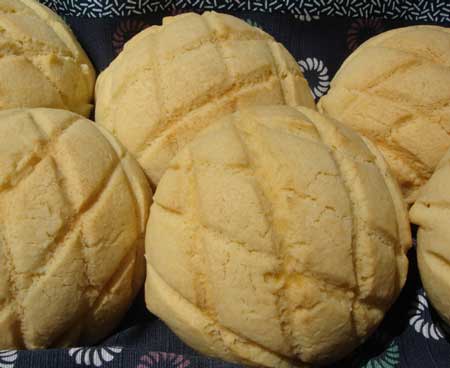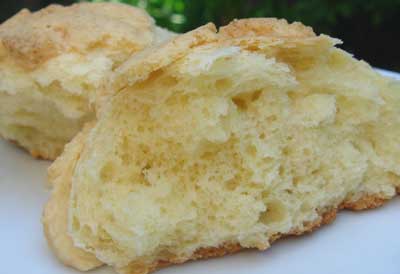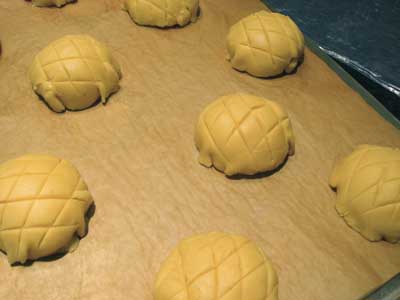Last week I wrote about some of the interesting Japanese breads I met on my recent vacation. Melon pan, a soft, sweet roll encased in cookie dough and scored to resemble a melon, captured my imagination as soon as I tried it, and I knew I would attempt to recreate this adorable little bread in my own kitchen.
I pulled elements from this recipe, and this one, as well as the Poor Man’s Brioche from Peter Reinhart’s The Bread Baker’s Apprentice.
I don’t have a lot of experience with sweet enriched breads, and the first time I made it, it was good, but the texture was denser than what I had had in Japan and what I wanted to create. So I increased the amount of egg and butter, and added the sugar and butter later in the process to give the gluten more chance to develop without interference from those ingredients. (Water is needed for gluten development. Sugar attracts water, pulling it away from the flour, and butter coats the protein, similarly keeping water away.)
I am satisfied with the flavor and texture of the bread; they are as close as I feel I need to get to the melon pan I found in Japanese bakeries. The color of my crumb, though, is quite yellower, so I guess it has much more butter and egg than authentic Japanese melon pan. Perhaps I will play with the recipe some more.
In the meantime, while this may not be the real thing, it is delicious, fun to make, and, for me, a nice memento of a memorable trip to a lovely and fascinating country.
Melon Pan
Yield: 9 2.5-ounce (3-inch-diameter) rolls
Time:
- Mix: 30 minutes
- First fermentation: 1.5 hours
- Divide and shape: 10 minutes
- Proof: 1 hour (during this time you also mix the cookie dough and “dress” the rolls)
- Bake: 20 minutes
- Cool: 45 minutes
Desired dough temperature: 80F
Ingredients for bread dough:
- 206 g white flour (I used Heartland Mills unbleached malted all-purpose)
- 49 g cold water
- 2.5 g (3/4 t.) dry instant yeast
- 3.7 g (5/8 t.) salt
- 80 g egg (about 2 small or 1.5 large)
- 29 g sugar
- 49 g unsalted butter, at room temperature
Ingredients for cookie dough:
- 51 g unsalted butter
- 65 g sugar
- 29 g egg
- 1.5 g (3/8 t.) vanilla extract
- 154 g pastry flour (I used Giusto’s organic)
- 3.1 g (3/4 t.) baking powder
- 2 g (1/3 t.) salt
Method:
- For bread dough: use a stand mixer. Mix flour, water, yeast, salt, and egg on low speed until just combined.
- Mix on medium speed for 4 minutes. The dough has quite a stiff consistency at this point.
- Turn back to low speed and add sugar in two batches. Mix on low speed until sugar is incorporated. The dough is softer after the addition of the sugar.
- Mix in medium speed about 10 minutes, until dough has reached a medium-high level of gluten development. The dough is soft and sticky.
- Again in low speed, add the butter and mix for a few minutes until it is incorporated.
- Turn to medium speed and mix about 6 minutes, until gluten is quite well developed.
- Transfer the dough to a container and cover tightly.
- Ferment at room temperature (72F – 76F) for about 1.5 hours, until approximately doubled in volume.
- Turn the dough out onto a lightly floured counter. Divide it into 9 pieces of about 43 g each.
- To shape each piece into a ball, place it on an unfloured section of counter and cup your hand lightly over it, with your hand resting on the counter. Move your hand quickly in a tight circular motion until the dough forms a smooth, tight ball.
- Place the dough balls on a cookie sheet lined with parchment paper. Cover the sheet with plastic wrap or slip it into a large plastic bag. The rolls will proof for about one hour altogether, or until nearly doubled in volume.
- Meanwhile, make the cookie dough: Cream butter and sugar until fluffy. Add egg and vanilla and beat until combined. Whisk flour with baking powder and salt, and sir the dry ingredients into the wet ones, mixing until just combined. Divide the dough into 9 balls of about 32 g each, and place them in the refrigerator.
- Preheat the oven to 360F.
- After the rolls have proofed for about 50 minutes, roll the cookie dough into 3.5-inch-diameter rounds and drape them over the rolls. The cookie dough encases the top and sides, but not the bottom, of the bread.
- Using a paring knife, score the cookie dough in a diamond pattern.
- Bake at 360F for 18-20 minutes, or until just beginning to brown.
- Cool on a wire rack. When completely cool, enjoy with a cup of coffee or green tea.



Hi Susan,
Thanks for your wonderful blog! looking forward to see more delightful recipes.
I will try your recipe for Melon Pan soon.
Zainab, thank you for stopping by! I’m glad you like my blog.
These look great I’ll have to try them soon I found this video on u tube making what I think are melon-pan very interesting http://www.youtube.com/watch?v=5zasWIrpCbE&mode=related&search=
Bakerbob, cool video, thanks!
Hi! this is first time visiting your blog. The first impression was what a great photos of breads!
I went down the left colum of photos and I saw melon pan! I love melon pan. Im glad you had the chance to visit Japan ( I am originally from Japan). I hope you enjoyed the bakeries there.
I tried making melon pan couple times before. I think the traditional way to top the cookie dough is doing so when you are shaping the dough. so when the ball of dough is proofing, the slashed cookie dough kind of seperates it self ,and streakes of bread dough peeks underneath.
I like the way you did it so It probobly doesnt matter that much , but don’t forget to put the granulated sugar on top!!
I just remember something interesting. I went to Mexico this summer, and the bakeries there had something very very similar to melon pan. The cookie on the top wasn’t as rich as the one in Japan , so it crubled alot. Melon pan might actuatly be originated from somewhere else!
sorry for the realy long comment. haha
Hello, aminet, thanks for visiting. I did really enjoy Japan and would love to go back. I didn’t realize I should put granulated sugar on top of the melon pan but I think it would be very good that way and will try it next time I make them. Thanks!
Ever since I was a kid living in East Los Angeles, I enjoyed eating Mexican Concha. When I went to Japan (for 17 years), I was surprised to find that concha was so popular there, too, in the form of melon pan. Now, I am not 100 percent sure that they are the same beast, but the similarities are too great. Given the fact that so many other of the famous Japanese breads have historical European connections, it seems likely that melon pan does too. Just hope there is no Euro equivalent for. . . AnPan! Yucch!
Ralston, melon pan and conchas are very similar, but I have found that conchas (at least the kind they have here) are much more dry than melon pan (at least the kind I had in Japan). I believe anpan is distinctly Japanese, and I do not find it distasteful at all, I have quite acquired a taste for sweet bean paste.
How do you get the markings so neat? The cookie dough tends to crumble on me when I try to roll it out (even though I do them one at a time and leave the rest in the fridge)? The notches we make never look very neat.
I’ve spent a while searching for melon pan recipes with pictures, and this is the best tutorial I’ve found so far– thanks!
When I saw the pictures for this recipe the first thing I thought was “conchas” a mexican pastry that is very common to have for breakfast. It’s so similar to this Japanese one, but the topping is much more simple made only with butter and confectioner’s sugar; then it is scored with a “cutter” that has the shape of a sea shell and that’s where it gets its name from. I use to make them at my first job but I dont know if I still have a recipe.
Maybe I will try this one and see how are they a like or different.
Ooo thanks. Although having it in cups would’ve made my life easier…*digs out scale* now lets see if this will let me measure correctly. 🙂
I tried making these the other night! Thanks for the teaspoon conversions, my kitchen scale can’t display fractions of grams, so it was nice to have an alternative.
These were really very good! The actual bun was a bit denser than I would have liked, but I’m picky about that sort of thing. I ended up using brown sugar in the cookie topping because I like the little bit of savory flavor it adds to the entire bun (even if it makes gauging the color harder), and the batch barely had time to cool before it was all gone.
Hi , I was searching the web for japanese bun receipe & came across your blog….Your bun looks great & I m getting excited to try out your receipe….:)
Just to share with you, it resembles one type of Asian bun – Polo Buns:
Here’s a link which has some nice pix of Polo Bun:
http://gracekitchencorner.blogspot.com/2008/08/polo-bun.html
anDY
Fr: Singapore
hello, thank you for sharing ur recipes. i m a amateur baker and tried making bread a few times using hand. My breas are soft and nice when it is out of the oven but turns hard, especially the crust, when cooled 🙁 Does ur recipe uses a bread machine? and how can i make the bread remain soft after it is cooled? thank you so much!
I’ve made your version of melon pan multiple times now and every time it has turned out to be fantastic, thank you!
I was wondering if you had ever tried filling your melon pan, and if you had if you could share any tips on fillings or methods?
XD weird-ass measurements you got there: 206 g , 49 g of water???, 29 g egg lol
I made conchas and loved them, now I want to try your melon pan. It really is fascinating how versions of this cookie topped bun are popular in both Japan and Mexico. I wonder what the connections is . . .
I’ve never heard of melon pan but these pictures are great. It really looks so light and fluffy.. I could probably eat about 20 of them. I think it looks like a great dinner roll.
-Sylvia
Digital Kitchen Scale
That looks absolutely amazing!
I’m going to try this tonight.
In fact, I might put a twist on it by adding some matcha green tea. Melon and matcha pan!
I’m drooling just thinking about it.
I lived in Japan for a few years and had a major love affair with their baked goods. I have now made this recipe three times and if my kids have any say, I will make it many more.
I think I may try making just the roll and putting some anko in the middle for some anpan.
Thanks for the great recipe.
hello have to tell you that this bread is Mexican and a is call CONCHAS